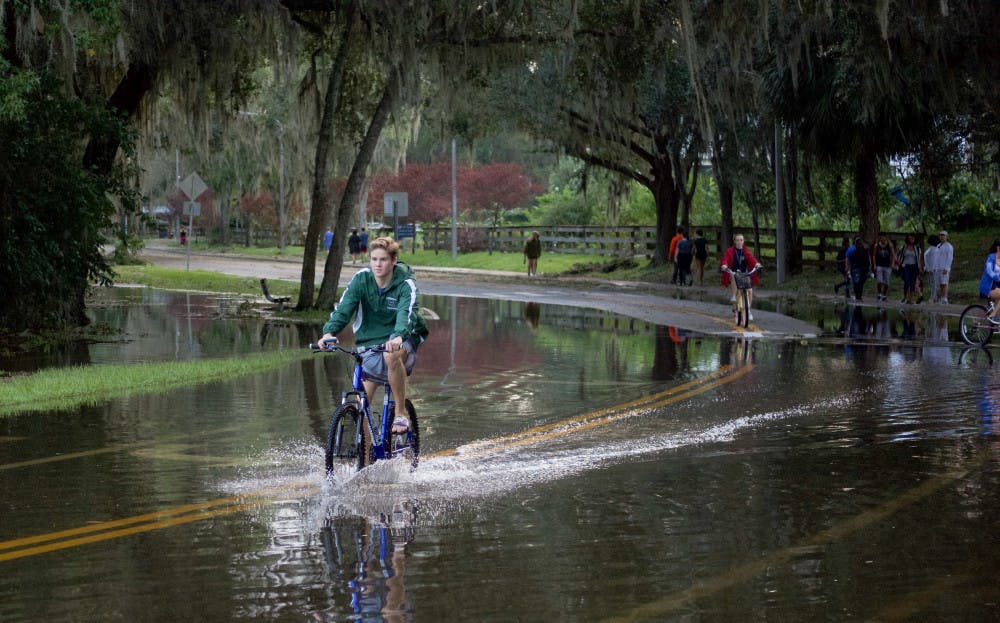Daniel Dickrell and his 10-year-old son Daniel cleared their street of branches and moss with matching rakes Monday, four hours after Category 1 Hurricane Irma hit Gainesville.
“I’m out of power, and I’m bored,” the UF mechanical and aerospace engineering professor said. “I figured I’d do something other than stare at a wall.”
Dickrell was one of 38,000 Gainesville residents who lost power during the storm. He stayed up until about 4 a.m. Monday watching the sky light up blue and green from exploding transformers.
“I hadn’t seen that before,” he said. “It was cool and scary at the same time.”
However, Gainesville Regional Utilities was quick to respond to outages. GRU is still working on restoring power to about 14,000 customers, said Gainesville Mayor Lauren Poe during a Tuesday telephone conference with the city’s emergency management officials. About 44,000 GRU customers in and around Gainesville have had their power restored, as of press time.
“That’s a remarkable job in a 24-hour period, and actually one of the best turnarounds in the entire state through this storm,” Poe said.
Power outages also affected many street lights, which were out Sunday, Monday and Tuesday.
In Marion County, one man died in the aftermath of Irma. At 3:20 a.m. Tuesday, a Mississippi man and another driver failed to stop at a broken light on the corner of U.S. 301 and Southeast 132nd Street Road and collided, according to a Florida Highway Patrol press release. The man was declared dead at the scene, and the other driver wasn’t injured.
More outages occurred at 20 lift stations — facilities that pump wastewater and sewage from lower elevations to higher elevations — out of the 170 stations in Gainesville. The city is asking residents to minimize their water usage until all the lift stations are up and running.
Gainesville Public Works Department has received 575 service calls since Saturday and is working to respond to all of them, Poe said. Residents have been warned to stay away from standing water in case of animals, electrical currents and other dangers.
City operations will resume normal hours Wednesday. Waste collection will be delayed one day from residents’ normal date.
During the height of the storm, Alachua County Sheriff’s Office Chief Sadie Darnell said ACSO received about 2,400 distress calls, which is almost double the average amount of calls they receive daily. Deputies responded to almost 400 hazardous conditions Monday.
Some Gainesville residents will still face repairs after the city and county finishes conducting emergency management.
Marty Parks, a Study Edge employee, said he felt his home shake during the storm as a large tree crashed through the ceiling and created four holes throughout the house. When the tree fell, Parks immediately tried to divert the falling water by using trash bags to funnel it into a bathroom sink.
The tree fell from the right side of the house, but was large enough that it covered the front and back of the house, he said.
“It punctured the house in a pretty inconvenient manner,” Parks said.
Parks and his roommates have to evacuate the house for a few days for repairs, he said.
On UF’s campus, which will reopen Wednesday and resume classes Thursday, there was minor damage from flooding and fallen trees.
Leaks were reported in buildings around campus, which included resident halls Beaty Towers and Jennings Hall, said UF spokesperson Janine Sikes. Six suites in Beaty had leaking water, and water collected in the lobby of Jennings Hall, she wrote in an email.
Maggie Stokes, a 19-year-old UF mathematics junior, had a roof leak in her ninth floor Beaty East dorm room around 1:30 a.m. Monday. Water also seeped into the apartment from around the windows.
Stokes and her roommates placed towels on the ground and under the windows and used trash cans to catch water. Stokes said her carpets were soaked, but it could have been worse. Last year, she said they experienced similar damage during Hurricane Matthew.
“Our situation wasn’t nearly the worst in Beaty,” she said. “Our RA said that some of the rooms were completely flooded, and people were moving all of their stuff out of the rooms.”
There are a couple of fallen trees around campus, including the big oak tree in front of the Physics Building, Sikes said.
Megan Newsome, a 21-year-old UF astrophysics senior, teared up when she saw the fallen tree, which had been standing for more than a century.
“It just feels like the tree was a part of the building that has been so integral to my time as a student since I’ve spent so much time there,” Newsome said.
After the storm had done its worst, Teddy Paddle, 46, walked his dogs, Luna and Matize, Monday morning and surveyed the damage on campus.
Paddle said he fled his coastal home in St. Petersburg and sought refuge with his son, a UF student. As he came across a large tree, which fell across the front pathway of Anderson Hall, he thought about the worst possibility for his St. Petersburg home: a storm surge.
“I haven’t heard from anybody in our neighborhood,” he said on Monday. “We all evacuated.”
Carl Beck, 68, also found shelter in Gainesville to escape a possible storm surge in St. Petersburg. He and six family members packed up the car and took back roads to Gainesville on Saturday after most Pinellas County residents had left.
“The path kept going from the east to the west to the east, and for days we thought we were safe enough to weather it out,” said Beck, who had never experienced a hurricane before.
Beck planed to return home Tuesday to assess damage.
“I’m cautiously optimistic that the place I live in is not flooded.”
Alachua County Commissioner Ken Cornell said the biggest surprise was the amount of flooding the county received. He said the county requested additional pumps with the hope of clearing standing water as quickly as possible. Flooding in Gainesville affected residents near Hogtown Creek, where water levels rose enough to cover roads.
Nathan Service, a 21-year-old UF public relations senior, lives near Hogtown Creek and watched the waters rise. Before he fell asleep at 1 a.m. Monday, he set an alarm every hour to check on the water level.
“It did get a little closer than comfortable, but it wasn’t unexpected,” Service said.
Though some roads in Gainesville were closed due to flooding, Gainesville Regional Transit System will resume with reduced service Wednesday and return to normal operations Thursday, Poe said.
There will be no service on routes 19, 21, 27, 28, 29, 36,37, 38, 39, 40, 46, 62, 76 and 77 on Wednesday. All UF campus and Later Gator routes will also not be in service, wrote Gainesville Police Officer Matt Goeckel in an email.
Routes running on reduced service Wednesday will be 9, 10, 12, 13, 20, 23, 33, 34, 35 and 43. The other routes will run like normal.
Ever since Jessica Valdes lost power, she’s relied on RTS.
Valdes, a 22-year-old UF political science and Portuguese senior, wrote in an email that she uses the bus to get to campus for homework and food because she can’t work or cook in her home at Oxford Manor Apartments.
The limited routes affect the amount of time Valdes spends on campus studying, but she said she can find another bus.
“I understand why there is limited service,” she said. “I am impressed with how much urgency and efficiency the city of Gainesville officials have acted to restore the city to its normal activities.”
Staff writers Jessica Giles, David Hoffman, Meryl Kornfield, Christina Morales, Jimena Tavel and Catie Wegman contributed to this report.
Students ride their bicycles through nearly a foot of water on the streets near Lake Alice. Lake Alice is one of the areas that flooded on campus during Hurricane Irma.
The tree that was in front of UF's Physics Building was split after Hurricane Irma passed through Gainesville. This tree was one of oldest live oaks on campus, living for more than century, according to the Physics Department website.
Plywood-boarded windows on a home located on the corner of West University Avenue and Northwest 20th Drive had the following phrases spray-painted on them: "Beat Irma" and "In All Kinds UF Weather."
Flood waters cover the crosswalks at the intersection of Museum Road and Corry Circle. Heavy rainfall from Hurricane Irma caused Lake Alice to overflow its banks.
A tree behind Anderson Hall lays strewn across UF campus Monday morning after Hurricane Irma passed through Gainesville.
Debris from Hurricane Irma lie on the sidewalks of the Reitz Union North Lawn on Monday afternoon.
A UF employee drives a bulldozer through Museum Road, which was flooded due to heavy rainfall from Hurricane Irma.
Matt Pfost greets fellow Gainesville Firefighter Brett Thomas as he exits a fire at the Oak Park Apartment complex on Monday morning. In the aftermath of Hurricane Irma, Gainesville Fire Rescue was unable to respond to calls until the winds slowed at about 5 a.m.





